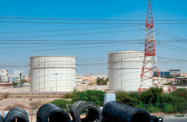A new mining strategy and mining law in Oman, plus efforts to improve port infrastructure, are expected to increase investment and promote growth in minerals exports.

A comprehensive national mining strategy, expected to guide sector development for the next 10 years, is expected to launch this year.
In early 2018 Hilal bin Mohammed al Busaidy, CEO of the Public Authority of Mining (PAM), announced that international consultants had submitted the completed draft of the strategy to PAM, which will review it prior to implementation.
The strategy is based on 12 pillars established by PAM to secure the sustainability of the sector and will focus on investment, environmental protection and local employment, among other measures.
Efforts to boost business will be further supported by a new mining law, also expected to come into effect this year. Drawn up by PAM, the law aims to streamline procedures for local and international investments in mining, speeding up and increasing the transparency of licensing processes, among other measures.
At the end of January Al Busaidy confirmed the legislation had received the support of Oman’s Council of Ministers and was awaiting approval from the State Council and the Majlis Al Shura, the lower chamber of the Council of Oman.
Government pursuing an active policy of sector growth
The incoming legislation is aimed at attracting further investment toward mining, which has been at the forefront of national economic diversification plans since 2014 and is one of the five non-oil sectors prioritised for development in the Ninth Five-Year Plan 2016-20.
As a result of increased emphasis on the sector, in February Ahmed bin Mohammed bin Salim Al Futaisi, the minister of transport and communications, announced his ministry was targeting year-on-year (y-o-y) growth in mineral exports. “We have already seen an increase in orders, and at the very least expect Sohar Port to export 15m tonnes of gabbro per year and the Port of Salalah to export 15m tonnes of gypsum per year,” he said.
Recent data also indicates the sector’s rising trade profile. In March the National Centre for Statistics and Information reported that exports of mineral products grew by 50.6% y-o-y in the first 10 months of 2017 to OR679.8m ($1.8bn).
To further facilitate export growth, port authorities are moving to expand capacity, undertaking development of a new 2m-twenty-foot-equivalent-unit container terminal at the Port of Duqm, which is expected to be operational by the end of 2019.
In February Reggy Vermeulen, CEO of the Port of Duqm, told the press that the master plan for development had been changed to add extra capacity in mineral roll-on/roll-off terminals.
Internal transport connections are also being improved. In February a royal decree was issued to the General Authority for Mining and the Oman Metals Development Company to determine the feasibility of the “Line of Metals”, a rail route to transport metals from Dhofar to Duqm.
If approved, the 375-km line will be built by Oman Railways and would form part of Oman’s contribution to the $200bn GCC Railway, which is currently scheduled for completion in 2021.
Sector drawing upstream and downstream investment
Since the start of this year a number of new investment announcements – particularly in development and exploration – indicate a strong mid- to long-term future for mining.
In January Oman’s mining authorities, Oman Mining Company (OMCO) and Minerals Development Oman (MDO) signed an exploration and development agreement with mining investment firm EXO Mining for copper and gold reserves in Block 10 near Yanqul in the Al Dhahirah Governorate. EXO will have a 51% stake in the project, with OMCO and MDO holding 21% and 29%, respectively.
Expected to lead to investments of over $100m in an initial three-year period, the agreement focuses on five known copper and gold deposits. These explorations cover just 10% of Block 10’s 370-sq-km area, leaving plenty of opportunity for further development.
Moreover, in early March, London-based Savannah Resources announced that the government had approved its licence application for copper mining in Maqail South.
Savannah Resources has also had seven of the eight required licensing approvals granted for the Mahab 4 site, with discussions on the final one under way. According to David Archer, CEO of Savannah Resources, the firm is confident that the remaining approval will be issued and that mining at both sites will begin in 2018.
Additionally, Gulf Mining is building five ferrochrome smelters at Sohar Port and Freezone to boost output of its iron and aluminium industries.


